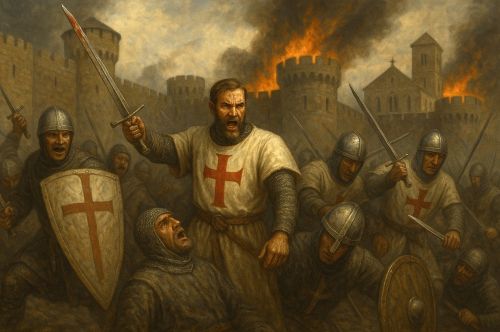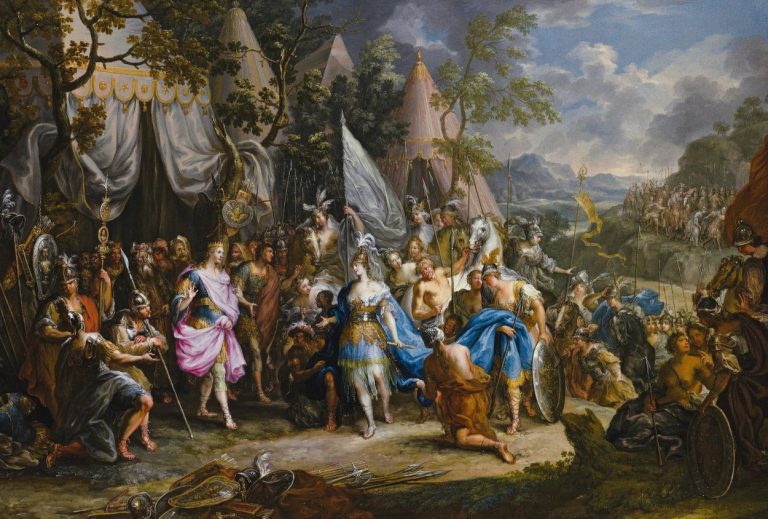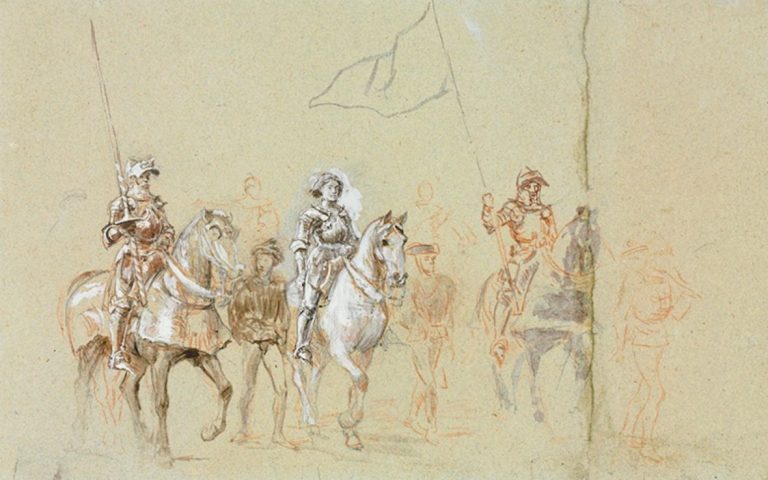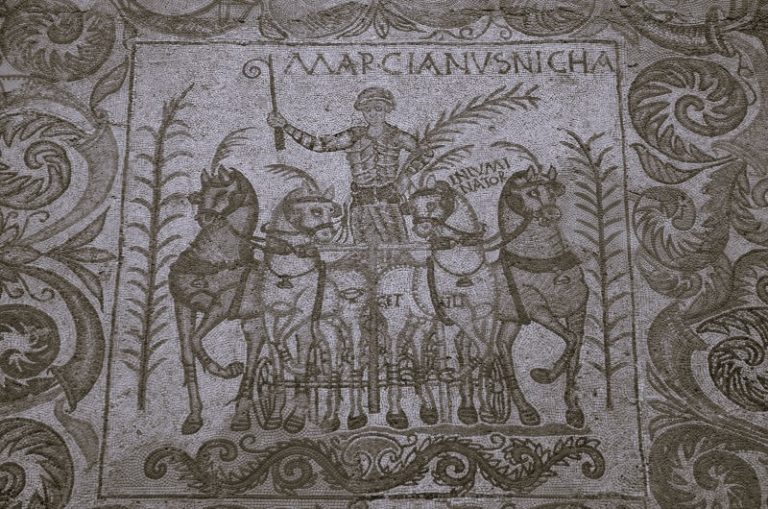

History’s cruel symmetry exposes the enduring paradox of faith and power: that those who kill in the name of heaven often destroy the very humanity they claim to defend.

By Matthew A. McIntosh
Public Historian
Brewminate
Introduction: The Paradox of Holy War
When Pope Urban II called the faithful to arms at Clermont in 1095, he spoke of liberating Jerusalem from “the infidel” and winning eternal salvation through the shedding of blood. He stood and delivered the words:
“Let those who have been accustomed unjustly to wage private warfare against the faithful now go against the infidels and end with victory this war which should have been begun long ago.”1
What followed was a movement unprecedented in medieval Europe: tens of thousands of knights and peasants, pilgrims and mercenaries, answering a divine summons to war. Yet before these crusaders ever reached the Holy Land, their swords turned upon their own neighbors, Jewish communities scattered along the Rhine, who became the first victims of a campaign sanctified in Christ’s name. The holy war that promised redemption became, almost immediately, an instrument of annihilation.
The First Crusade’s bloodletting in Speyer, Worms, and Mainz in 1096 was not an accident of mob violence. Chroniclers such as Albert of Aachen and the anonymous Gesta Francorum recorded these massacres as acts of misplaced zeal, yet even their disapproval reveals the pervasive logic of exclusion at work.2 The crusading enterprise fused penitence with purification; in slaying those deemed Christ’s enemies, crusaders imagined themselves cleansing both the world and their souls. As Thomas Asbridge notes, this “spiritual militarism” was not only directed toward the Muslim East but also reshaped the moral geography of Europe itself.3
The ideology that propelled men toward Jerusalem thus began as an inward purge. The same theology that envisioned a sanctified land demanded a sanctified Christendom, one purged of Jews, Muslims, and Pagans alike. The peregrinatio Christi (“pilgrimage of Christ”) was, in practice, a march of vengeance. The contradiction was absolute: in seeking to recover the earthly city of God, crusaders desecrated the divine image in others. What they called liberation, history remembers as the consecration of hatred.
The Rhineland Massacres: The “Internal Crusade”

In the spring and summer of 1096, as the first waves of crusaders marched eastward, a second war was waged at home. Preachers and nobles alike inflamed the conviction that if enemies of Christ deserved destruction abroad, those who “murdered” him should not be spared within Christendom. What began as a campaign for Jerusalem quickly became a campaign against Europe’s Jews, a catastrophe remembered in both Christian chronicles and Jewish lamentations as the Rhineland massacres.
In the cities of Speyer, Worms, and Mainz, mobs of crusaders and local townsmen attacked Jewish quarters, plundering property, forcing conversions, and slaughtering entire communities. Albert of Aachen described the scenes in words both horrified and approving: Jews, he wrote, were “cut down like cattle” as men and women sought death by their own hands rather than baptism by force.4 The Solomon bar Simson Chronicle, written from within the Jewish community itself, transforms the massacre into sacred testimony, recounting how parents slew their children and then themselves to avoid apostasy, martyrs in a perverse mirror of the crusaders’ own ideal of redemptive death.5
This “internal crusade” was not spontaneous chaos. Bishop John of Speyer attempted to shield his city’s Jews, as did Archbishop Ruthard of Mainz, but their defenses collapsed under the weight of crusading fervor.6 The perpetrators included not only ragtag bands of the so-called People’s Crusade led by Count Emicho of Leiningen but also local burghers and clergy who viewed the Jews as an obstacle to divine favor. Robert Chazan argues that these massacres demonstrate “a new totalism of Christian self-conception,” one that fused piety with purgation and saw the shedding of Jewish blood as an extension of the holy war itself.7
The violence in the Rhineland thus reveals the Crusades’ first true battlefield: the Christian conscience. Before Jerusalem’s walls fell, the gates of European cities had already been drenched in blood. The distinction between “infidel abroad” and “infidel within” collapsed entirely, inaugurating an age in which the defense of Christendom became inseparable from the persecution of its minorities.8
Anti-Judaism and the Theology of Exclusion

The violence of 1096 was not a mere outbreak of hysteria; it was the logical fruit of a theology that had long defined Christianity through negation. Medieval Christendom understood itself as the verus Israel, the true Israel, and in this framework, the continued existence of Jews, unconverted and unbowed, posed an intolerable contradiction to divine history.9 The crusading age intensified this paradox, turning centuries of anti-Jewish polemic into a moral program for purification.
Preachers who rallied the crusaders did not invent hatred of the Jews, but they magnified it into a vision of cosmic warfare. Peter the Venerable of Cluny denounced Jews as “a race more than diabolical,” whose stubbornness perpetuated the crucifixion in every generation.10 Bernard of Clairvaux, though condemning unauthorized attacks, nonetheless accepted the underlying premise: that the Jews’ suffering was divinely ordained.11 Such rhetoric transformed theological metaphor into social policy. By defining holiness as separation from unbelief, the Church rendered violence not only permissible but salvific.
In the twelfth century, as crusading zeal became institutionalized, this ideology took deeper root. Anti-Jewish discourse flourished in the intellectual revival of the period, when scholars such as Peter Abelard and Gilbert Crispin debated Jewish interlocutors not to understand but to refute.12 The scholastic culture that produced the Summa also produced the “Jewish Question” as a permanent category of thought, a problem to be managed until the end of time. The ritual of disputation replaced the sword, yet the purpose was the same: to reaffirm Christian supremacy through the humiliation of the other.
This theology of exclusion also extended beyond Judaism. The same moral architecture that defined the Jew as obstinate defined the Pagan as ignorant and the Muslim as heretical.13 The crusader’s sword thus became the visible form of a metaphysical idea, that purity of faith required the erasure of difference. Anti-Judaism was not an aberration within crusading Christianity; it was its foundation, the spiritual grammar through which the movement understood itself.
Jerusalem and the Logic of Total Domination

When the crusaders reached Jerusalem in July 1099, their pilgrimage culminated in a vision of holiness inseparable from horror. The siege had been long and brutal, and when the city walls finally yielded, the sacred geography of the Christian imagination became a battlefield. Pope Urban II had framed the Crusade as a journey of redemption, a pilgrimage to reclaim the “navel of the world.” Yet when Jerusalem fell, it was not salvation that entered its gates, but vengeance.14
The massacre that followed stunned even some contemporaries. Raymond of Aguilers, an eyewitness, wrote that the crusaders “rode in blood up to the knees of their horses,” a detail both symbolic and grotesque.15 Streets ran red as thousands of Muslims and Jews were slaughtered, and even Eastern Christians who resisted Latin rule faced expulsion or death. To the crusaders, this carnage fulfilled prophecy: purification through blood. The violence was not an excess of zeal but its consummation, a liturgy performed with the sword.
Fulcher of Chartres and other chroniclers recorded the conquest with a tone of triumph, proclaiming that divine justice had been restored.16 In their accounts, the city’s capture marked the victory of God’s people over His enemies. But this triumphalism concealed a profound inversion of faith. The crusaders believed they were redeeming the land of Christ; in reality, they re-enacted the passion through their victims. Holiness was measured by the destruction of the impure, and redemption was imagined as the cleansing of the earth from unbelief.
The Jews of Jerusalem, trapped within this theology of annihilation, fled to their synagogue seeking sanctuary. The crusaders barred the doors and set the building alight while chanting the Te Deum.17 The act was both literal and allegorical, an attempt to erase Judaism from the city that had birthed it. Within the flames of that synagogue, the crusading ideal revealed its core contradiction: a religion of love wielded as a weapon of purification. The holy fire that was meant to sanctify consumed instead the very humanity it claimed to defend.
The fall of Jerusalem became a model for later crusades. It set the moral precedent for all that followed: the belief that “purity could be achieved only through annihilation.”18 Success was measured not in negotiation or coexistence but in erasure. Every subsequent campaign (in Edessa, Antioch, Acre, or even against European heretics) sought to replicate the miracle of 1099, when divine favor seemed to descend through slaughter. The conquest of the Holy City thus became the moral touchstone of a faith that had confused sanctity with supremacy.
The idea of Jerusalem outlasted the city itself.19 The crusader states eventually crumbled, yet the theological logic that had animated them endured. By the thirteenth century, crusading zeal had turned fully inward, against Muslims in Spain, Pagans in the Baltic, and Jews across Western Europe. The “holy war” that began at Jerusalem did not end there; it returned home, a sanctified violence perpetuated in every expulsion, inquisition, and forced conversion that followed. The capture of the Holy City had inaugurated not the triumph of heaven, but the normalization of persecution.
Europe’s Continuing Crusades: Expulsions and Forced Conversions

By the thirteenth century, the crusading spirit no longer required the sands of Palestine. Its ideology (forged in sermons, solidified in blood) had turned homeward. The concept of bellum sacrum, or holy war, was now applied to internal enemies: Jews, Muslims, heretics, and Pagans who lived within the boundaries of Christendom itself. The rhetoric of Jerusalem became the language of Europe. Kings and prelates proclaimed new crusades not to reclaim distant lands, but to purify their own realms, transforming faith into a mechanism of control.20
The Papacy’s institutionalization of crusading granted the machinery of persecution a permanent legitimacy. Indulgences were extended to those who fought the Albigensians in southern France or the Pagans in the Baltic, and by extension, to those who expelled or coerced the Jews.21 The logic was the same that had guided the First Crusade, spiritual renewal through elimination of impurity. In 1290, King Edward I ordered all Jews expelled from England; Philip IV of France followed in 1306 and again in 1394; Spain’s Catholic Monarchs would complete the pattern in 1492.22 Each act was celebrated as an act of national sanctification, a crusade in miniature.
These expulsions were not isolated decrees but the culmination of centuries of theological exclusion. Royal edicts were accompanied by sermons framing the Jew as both pollutant and threat. Chroniclers justified the measures through the language of divine retribution, the same moral calculus that had sanctified slaughter at Jerusalem. These policies emerged from a Christian culture that “could not imagine coexistence without hierarchy.”23 Jews could live only as witnesses to their own defeat, or not at all. The crusader’s sword had been replaced by law, but its purpose remained unchanged.
In Iberia, the Spanish Reconquista transformed crusading into imperial theology. Victory over Muslims in Granada was hailed as the restoration of God’s order, while the 1492 Alhambra Decree completed the purification by driving out the Jews.24 Conversion, when offered, was rarely a choice; it was submission disguised as salvation. Baptismal fonts replaced the battlefield, and the Inquisition enforced orthodoxy as a continuation of crusading zeal by bureaucratic means. The line between piety and policy dissolved entirely, the cross had become an instrument of statecraft.
This transformation was the birth of “communities of violence,” societies that defined their unity through ritualized persecution.25 What began as a campaign to liberate the Holy Land became a cultural reflex, the reflex to purge, to sanctify through suffering. By the end of the fifteenth century, the crusading ideal had conquered its own world. The enemies of Christ were no longer at the gates; they were within, and their destruction was the measure of faith. Europe had become Jerusalem, not redeemed, but reenacting its fall again and again.
Conclusion: The Legacy of Sanctified Exclusion
The Crusades began as a project of alleged liberation and ended as a theology of exclusion. What was framed as a divine summons to recover holy ground became a moral grammar for purging human difference. The massacres in the Rhineland, the bloodshed at Jerusalem, and the expulsions from Europe formed a single arc, the evolution of a spiritual ideal into a machinery of persecution. Each crusade, whether waged with sword or statute, reasserted the same principle: that holiness demanded homogeneity.26 This conviction did not vanish with the fading of medieval Christendom; it migrated into the structures of modern nationalism and colonialism, where the rhetoric of purity continued to mask violence in the language of virtue.
Historians have shown that medieval anti-Judaism was not a series of episodic hatreds but a worldview, a way of ordering reality.27 To define oneself as Christian meant defining another as perpetual outsider, and this logic proved adaptable to every new age. The theological template that sanctified the crusader’s slaughter of Jews and Muslims also informed later European empires that claimed to “civilize” through domination. From the pogroms of early modern Europe to the racial ideologies of the twentieth century, the legacy of the Crusades lay not in their conquests but in the enduring belief that violence could redeem.
In this light, the contrast with 1948 is not one of simple reversal but of profound moral divergence. The medieval crusader sought to erase the Jew from the Holy Land; the modern Jewish state emerged from the memory of that erasure, seeking not conquest but survival.28 The same soil that once absorbed the blood of persecution became the ground of a people’s return and ironically blood once again as the returning people sought to then exclude those already there. History’s cruel symmetry thus exposes the enduring paradox of faith and power: that those who kill in the name of heaven often destroy the very humanity they claim to defend. The sword that once sanctified exclusion continues to hang, a reminder that redemption sought through domination is no redemption at all.
Appendix
Footnotes
- Fulcher of Chartres, Historia Hierosolymitana (A History of the Expedition to Jerusalem), trans. Frances Rita Ryan (Knoxville: University of Tennessee Press, 1969), 66–68.
- Albert of Aachen, Historia Ierosolimitana: History of the Journey to Jerusalem, trans. Susan B. Edgington (Oxford: Clarendon Press, 2007), 44–51.
- Thomas Asbridge, The First Crusade: A New History (Oxford: Oxford University Press, 2004), 85.
- Albert of Aachen, Historia Ierosolimitana: History of the Journey to Jerusalem, trans. Susan B. Edgington (Oxford: Clarendon Press, 2007), 46–49.
- The Chronicle of Solomon bar Simson, in Shlomo Eidelberg, The Jews and the Crusaders: The Hebrew Chronicles of the First and Second Crusades (Madison: University of Wisconsin Press, 1977), 27–35.
- Christopher Tyerman, God’s War: A New History of the Crusades (Cambridge, MA: Harvard University Press, 2006), 97–99.
- Robert Chazan, European Jewry and the First Crusade (Berkeley: University of California Press, 1987), 123.
- Jeremy Cohen, Sanctifying the Name of God: Jewish Martyrs and Jewish Memories of the First Crusade (Philadelphia: University of Pennsylvania Press, 2004), 58–61.
- Gavin I. Langmuir, Toward a Definition of Antisemitism (Berkeley: University of California Press, 1990), 59–63.
- Peter the Venerable, Adversus Judaeorum Inveteratam Duritiem, in Patrologia Latina, vol. 189, ed. J.-P. Migne (Paris, 1854), cols. 546–549.
- Bernard of Clairvaux, Epistolae, no. 363, in Sancti Bernardi Opera, vol. 8, ed. Jean Leclercq et al. (Rome: Editiones Cistercienses, 1977), 317–320.
- Anna Sapir Abulafia, Christians and Jews in the Twelfth-Century Renaissance (London: Routledge, 1995), 41–48.
- R.I. Moore, The Formation of a Persecuting Society: Authority and Deviance in Western Europe 950–1250 (Oxford: Blackwell, 1987), 92–95.
- Jonathan Riley-Smith, The First Crusaders, 1095–1131 (Cambridge: Cambridge University Press, 1997), 113–115.
- Raymond of Aguilers, Historia Francorum Qui Ceperunt Iherusalem, trans. John H. Hill and Laurita L. Hill (Philadelphia: American Philosophical Society, 1968), 139.
- Fulcher of Chartres, A History of the Expedition to Jerusalem, trans. Frances Rita Ryan (Knoxville: University of Tennessee Press, 1969), 119–121.
- Albert of Aachen, Historia Ierosolimitana, trans. Susan B. Edgington (Oxford: Clarendon Press, 2007), 130–132.
- Thomas F. Madden, The Concise History of the Crusades, 3rd ed. (Lanham, MD: Rowman & Littlefield, 2013), 35.
- Christopher Tyerman, The Invention of the Crusades (Toronto: University of Toronto Press, 1998), 54.
- Christopher Tyerman, God’s War: A New History of the Crusades (Cambridge, MA: Harvard University Press, 2006), 713–716.
- Jonathan Riley-Smith, The Crusades: A History, 3rd ed. (New Haven: Yale University Press, 2014), 310–312.
- Edward I, “Edict of Expulsion,” July 18, 1290, in English Historical Documents, vol. 3, ed. Harry Rothwell (London: Routledge, 1975), 31–33; Philip IV of France, “Expulsion of the Jews,” 1306, in Documents relatifs à l’histoire des Juifs de France, ed. Henri Gross (Paris: Imprimerie nationale, 1897), 118–122.
- Mark R. Cohen, Under Crescent and Cross: The Jews in the Middle Ages (Princeton: Princeton University Press, 1994), 115.
- Ferdinand and Isabella, “The Alhambra Decree,” March 31, 1492, in Medieval Iberia: Readings from Christian, Muslim, and Jewish Sources, ed. Olivia Remie Constable (Philadelphia: University of Pennsylvania Press, 1997), 422–426.
- David Nirenberg, Communities of Violence: Persecution of Minorities in the Middle Ages (Princeton: Princeton University Press, 1996), 202–205.
- R.I. Moore, The War on Heresy: Faith and Power in Medieval Europe (Cambridge, MA: Harvard University Press, 2012), 241–243.
- David Nirenberg, Anti-Judaism: The Western Tradition (New York: W.W. Norton, 2013), 55–59; Anna Sapir Abulafia, Christian–Jewish Relations, 1000–1300: Jews in the Service of Medieval Christendom (London: Routledge, 2011), 89–94.
- Amos Elon, The Pity of It All: A History of Jews in Germany, 1743–1933 (New York: Metropolitan Books, 2002), 14–16.
Bibliography
- Abulafia, Anna Sapir. Christians and Jews in the Twelfth-Century Renaissance. London: Routledge, 1995.
- ———. Christian–Jewish Relations, 1000–1300: Jews in the Service of Medieval Christendom. London: Routledge, 2011.
- Albert of Aachen. Historia Ierosolimitana: History of the Journey to Jerusalem. Translated by Susan B. Edgington. Oxford: Clarendon Press, 2007.
- Asbridge, Thomas. The First Crusade: A New History. Oxford: Oxford University Press, 2004.
- Bernard of Clairvaux. Epistolae, no. 363. In Sancti Bernardi Opera, vol. 8, edited by Jean Leclercq, C.H. Talbot, and H.M. Rochais. Rome: Editiones Cistercienses, 1977.
- Chazan, Robert. European Jewry and the First Crusade. Berkeley: University of California Press, 1987.
- Cohen, Jeremy. Sanctifying the Name of God: Jewish Martyrs and Jewish Memories of the First Crusade. Philadelphia: University of Pennsylvania Press, 2004.
- Cohen, Mark R. Under Crescent and Cross: The Jews in the Middle Ages. Princeton: Princeton University Press, 1994.
- Edward I. “Edict of Expulsion,” July 18, 1290. In English Historical Documents, vol. 3, edited by Harry Rothwell, 31–33. London: Routledge, 1975.
- Eidelberg, Shlomo, ed. The Jews and the Crusaders: The Hebrew Chronicles of the First and Second Crusades. Madison: University of Wisconsin Press, 1977.
- Elon, Amos. The Pity of It All: A History of Jews in Germany, 1743–1933. New York: Metropolitan Books, 2002.
- Ferdinand and Isabella. “The Alhambra Decree,” March 31, 1492. In Medieval Iberia: Readings from Christian, Muslim, and Jewish Sources, edited by Olivia Remie Constable, 422–426. Philadelphia: University of Pennsylvania Press, 1997.
- Fulcher of Chartres. A History of the Expedition to Jerusalem. Translated by Frances Rita Ryan. Knoxville: University of Tennessee Press, 1969.
- Langmuir, Gavin I. Toward a Definition of Antisemitism. Berkeley: University of California Press, 1990.
- Madden, Thomas F. The Concise History of the Crusades. 3rd ed. Lanham, MD: Rowman & Littlefield, 2013.
- Moore, R.I. The Formation of a Persecuting Society: Authority and Deviance in Western Europe 950–1250. Oxford: Blackwell, 1987.
- ———. The War on Heresy: Faith and Power in Medieval Europe. Cambridge, MA: Harvard University Press, 2012.
- Nirenberg, David. Anti-Judaism: The Western Tradition. New York: W.W. Norton, 2013.
- ———. Communities of Violence: Persecution of Minorities in the Middle Ages. Princeton: Princeton University Press, 1996.
- Peter the Venerable. Adversus Judaeorum Inveteratam Duritiem. In Patrologia Latina, vol. 189, edited by J.-P. Migne, cols. 546–549. Paris, 1854.
- Philip IV of France. “Expulsion of the Jews,” 1306. In Documents relatifs à l’histoire des Juifs de France, edited by Henri Gross, 118–122. Paris: Imprimerie nationale, 1897.
- Raymond of Aguilers. Historia Francorum Qui Ceperunt Iherusalem. Translated by John H. Hill and Laurita L. Hill. Philadelphia: American Philosophical Society, 1968.
- Riley-Smith, Jonathan. The Crusades: A History. 3rd ed. New Haven: Yale University Press, 2014.
- ———. The First Crusaders, 1095–1131. Cambridge: Cambridge University Press, 1997.
- Tyerman, Christopher. God’s War: A New History of the Crusades. Cambridge, MA: Harvard University Press, 2006.
- ———. The Invention of the Crusades. Toronto: University of Toronto Press, 1998.
Originally published by Brewminate, 10.16.2025, under the terms of a Creative Commons Attribution-NonCommercial-NoDerivatives 4.0 International license.


